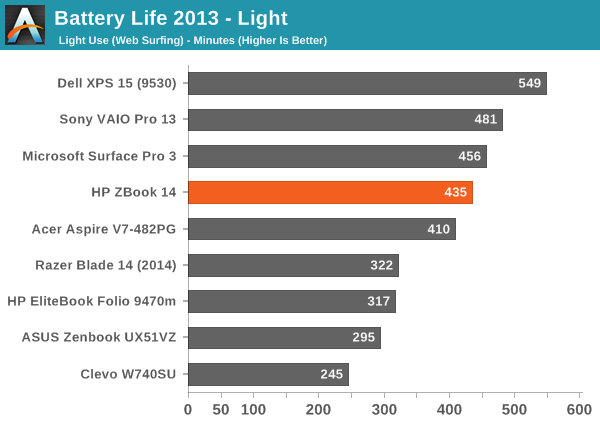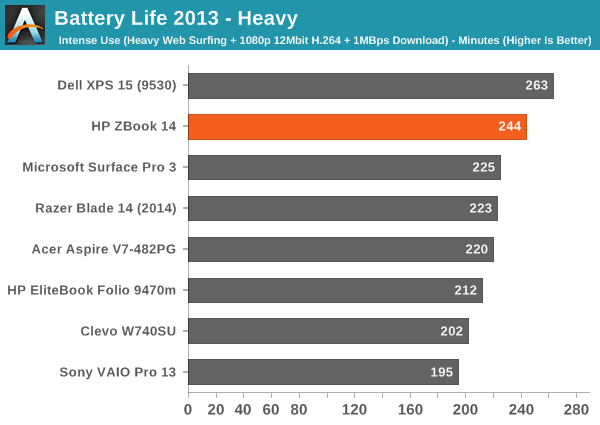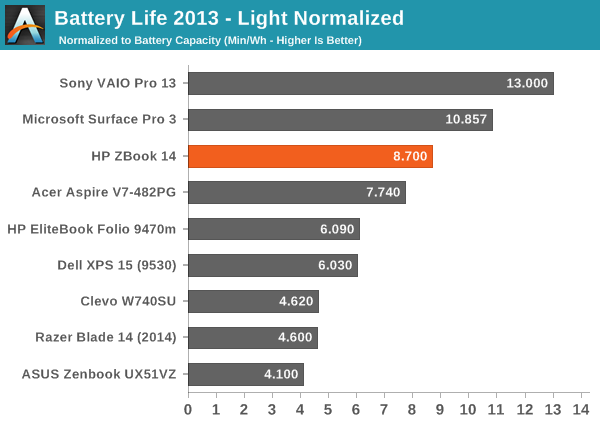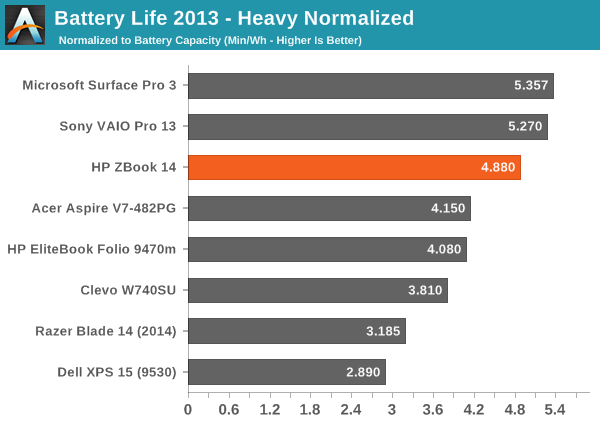HP ZBook 14 Review: Mobile Workstation Meets Ultrabook
by Jarred Walton on June 20, 2014 2:30 AM ESTHP ZBook 14: Battery Life
Our final benchmark is a test of battery life. Here's where HP runs into a bit of trouble, as the default software installation ends up negatively impacting battery life. I usually leave on the manufacturer utilities, but in this case HP has a security suite that results in about 15-20% less battery life. I ran the battery tests first with the software installed and then again after uninstalling, and the difference was quite dramatic. The problem is that some companies might actually like the HP software suite, and if so you'll just have to know you're going to lose out on some power savings. For testing, the LCD was run at 85% brightness (200 nits); we've switched our 1080p video and playback software for 2014, and as this laptop is running Windows 7 instead of Windows 8.1 we opted to use Windows Media Player as an alternative to the Win8 Video app.




Even without the extra HP software dragging battery life down, the results here are merely good and not exceptional. Seven hours of light use and four hours of heavy use might be enough to get you through the day, but more likely than not you'll want to bring along the AC adapter – just in case. As another option, HP does sell a slice battery that works with the ZBook 14, so you can sacrifice weight and thickness to basically double the battery life. The slice battery is also "intelligent" – the laptop will discharge the slice battery first and charge the integrated battery first, so you can potentially leave the slice in your bag and continue using the laptop when the power is drained.
Normalized battery life has the ZBook leading several other laptops, but at least the Sony VAIO Pro 13 and the new Surface Pro 3 maintain an efficiency advantage. Some of that might be due to the larger LCD on the ZBook, but while that could potentially narrow the gap in the Heavy workload, in the Light workload we're looking at a relatively large deficit.










66 Comments
View All Comments
Zoomer - Tuesday, June 24, 2014 - link
Win 8 is actually a step back as the start screen forces your attention away from what you were doing.CharonPDX - Friday, June 20, 2014 - link
Find me a large enterprise that spends $2000 on mobile workstations that has switched to Win 8.x. (Other than Microsoft.).
.
Still looking? Yeah, that's why Windows 7.
retrospooty - Friday, June 20, 2014 - link
Windows 8? This is marketed toward business users. No businesses use Win 8 and they wont until the UI is fixed.jabber - Friday, June 20, 2014 - link
MS knew most businesses wouldn't switch to 8 anyway as it's not in the Corporate Refresh cycle set all the way back in 1999 by Y2K when most moved to lovely fresh NT4 machines.Windows 9/10 will fit in far better. However as general business computing requirements have dropped drastically over the past 8 years I can see a lot of corporates holding out till 10.
jeffkibuule - Sunday, June 22, 2014 - link
Let's also be honest here, businesses would still be installing machines with Windows XP if they could. Popular opinion != correct opinion.Zhongrui - Friday, June 20, 2014 - link
To be frank I love Windows 7 much much better than Windows 8.1U1. If the LCD is not a touch screen, it is really not necessary to use Windows 8.1U1, which is totally ugly and puts too much junk on your HDD/SSD.edwpang - Friday, June 20, 2014 - link
Totally opposite to your claim, Windows 8/8.1 can clear up windows update and software installations better than windows 7. It added more options to clean up the winSxS folder in the DISM.exe command. For example:***
Using the /ResetBase switch with the /StartComponentCleanup parameter of DISM.exe on a running version of Windows 8.1 removes all superseded versions of every component in the component store.
***
Also with Win8.1U1, it has a new feature WIMBoot to save disk space further. Just google for WIMBoot to see for yourself.
peterfares - Friday, June 20, 2014 - link
That /ResetBase option is AWESOME. It's also automatically run every month or two I believe.It has kept my Windows 8.1 install size only slightly larger than when I originally installed it. Windows 7 SP1 when first installed is pretty small but after applying all the updates (and there have been a LOT since SP1) it becomes pretty huge, much larger than Windows 8.1
extide - Saturday, June 21, 2014 - link
There is actually an identical tool for windows 7. It doesnt come with it, but you can find it, I believe it is called MS Deep Clean.edwpang - Sunday, June 22, 2014 - link
Windows 8.1 run the /StartComponentCleanup automatically without /ResetBase according to MS technet.